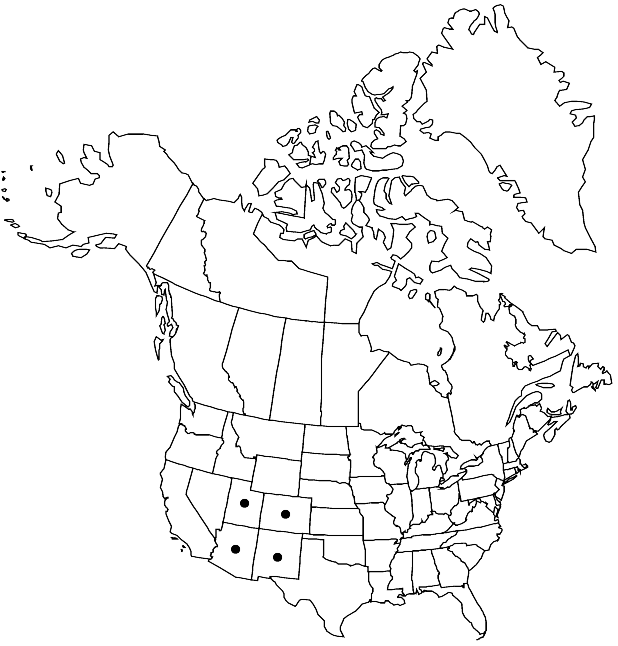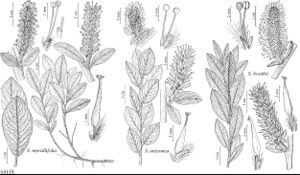Salix arizonica
Canad. J. Bot. 53: 1499. 1975.
Plants 0.3–2.6 m. Stems: branches redbrown or yellowbrown, not or weakly glaucous, glabrous or pilose at nodes; branchlets yellow-green, redbrown, or brownish, pilose. Leaves: stipules foliaceous, apex convex or rounded; petiole convex to flat, or shallowly grooved adaxially, 2–7.5 mm, villous or pubescent to glabrescent adaxially; largest medial blade (sometimes amphistomatous), elliptic or broadly elliptic, 20–50 × 10–31 mm, 1.6–2–2.8 (–3.6) times as long as wide, base convex, rounded, or cordate, margins flat, serrulate or entire, apex acute, convex, or acuminate, abaxial surface not glaucous, pilose or glabrous, hairs wavy, adaxial slightly glossy, pilose or glabrous; proximal blade margins entire, serrulate, or crenulate; juvenile blade green, glabrous or pilose abaxially, hairs white. Catkins flowering as leaves emerge; staminate stout, subglobose, or globose, 7–17 × 6–10 mm, flowering branchlet 1–3 mm; pistillate densely or moderately densely flowered, stout or subglobose, 12–38 × 6–12 mm, flowering branchlet 1.5–10 mm; floral bract brown, black, or bicolor, 1–2 mm, apex acute or convex, abaxially hairy, hairs wavy. Staminate flowers: adaxial nectary narrowly oblong to oblong, 0.4–0.8 mm; filaments distinct, glabrous; anthers purple turning yellow, 0.4–0.6 mm. Pistillate flowers: adaxial nectary narrowly oblong to oblong, 0.4–1 mm, shorter to longer than stipe; stipe 0.2–1 mm; ovary pyriform, glabrous, beak gradually tapering to or slightly bulged below styles; ovules 8–12 per ovary; styles 0.5–1.2 mm; stigmas broadly cylindrical, 0.14–0.21–0.36 mm. Capsules 3.2–4.5 mm. 2n = 38.
Phenology: Flowering late May-late Jun.
Habitat: Subalpine sedge meadows, along streams, wet drainageways, cienegas
Elevation: 2600-3400 m
Distribution

Ariz., Colo., N.Mex., Utah.
Discussion
Of conservation concern.
Salix arizonica is very similar to S. boothii. They were separated by Dorn on the presence of five flavonoid compounds identified in S. boothii not found in S. arizonica. Some morphological differences were noted but the characters used to separate them are quite variable. The most important feature seems to be the usually broader leaves of S. arizonica. In addition, the diploid chromosome number for S. arizonica separates it from the tetraploid S. boothii. Although the two are distinct species, the overlap in their morphological characters suggests that positive identification needs to be based on chromosome number or chromatographic analysis.
Salix arizonica is distinguished from S. boothii by having stipule apices convex to rounded, petioles 3–7.5 mm, juvenile blades glabrous or hairy, hairs white, largest medial blades elliptic or broadly elliptic, 20–50 mm, 1.6–3.6 times as long as wide, abaxial surfaces with white hairs, staminate catkins 1–1.7 times as long as broad, pistillate catkins 1.2–2.8 times as long broad, floral bract apices acute to convex, nectaries narrowly oblong to oblong, staminate nectaries 0.4–0.8 mm, anthers 0.4–0.6 mm, filaments distinct, glabrous, pistillate nectaries shorter to longer than stipes, stipes 0.2–1 mm, stigmas broadly cylindrical, and capsules 3.2–4.5 mm; S. boothii has stipule apices acuminate or acute to rounded, petioles 3–17 mm, juvenile blades hairy, hairs white, sometimes also ferruginous, largest medial blades lorate to narrowly or broadly elliptic, 26–102 mm, 2–5.2 times as long as wide, abaxial surfaces with white, sometimes also ferruginous, hairs, staminate catkins 1.2–3.1 times as long as broad, pistillate catkins 1.4–4.1 times as long as broad, floral bract apices rounded or retuse, nectaries narrowly oblong to ovate or flask-shaped, staminate nectaries 0.6–1.5 mm, anthers 0.48–0.8 mm, filaments distinct to connate about half their lengths, glabrous or hairy, pistillate nectaries shorter than stipes, stipes 0.5–2.5 mm, stigmas flat, abaxially non-papillate with rounded tip, slenderly cylindrical or plump, and capsules 2.5–6 mm.
Salix arizonica, originally known from Mt. Baldy in east-central Arizona, was proposed for listing under the United States Endangered and Threatened Wildlife and Plants Act, but the proposal was withdrawn when additional populations were discovered in southern Utah and in New Mexico; it is now listed as a “sensitive species” (K. Decker, www.fs.us/r2/projects/scp/assessments/salixarizonica.pdf). Major conservation concerns are from browsing by cattle and elk (J. Maschinski 2001) and Melampsora infection (M. L. Fairweather 1993; R. A. Obedzinski et al. 2001). The Arizona populations receive minimal protection from cattle and wildlife browsing by exclosures and by introduction into new localities. The Arizona and Utah populations have a genetic similarity of ca. 37%, which has been attributed to a period of panmixis followed by a long period of isolation in regions with different environments (J. T. Thompson et al. 2003).
Salix arizonica is in the Center for Plant Conservation’s National Collection of Endangered Plants.
Hybrids:
Salix arizonica forms natural hybrids with S. brachycarpa, S. eastwoodiae, and S. lutea.
Salix arizonica × S. brachycarpa var. brachycarpa occurs in southern Utah. Its parentage is supported by chromatographic data (E. D. McArthur, pers. comm.).
Selected References
None.
Lower Taxa
"-0.36mm" is not declared as a valid unit of measurement for this property.
